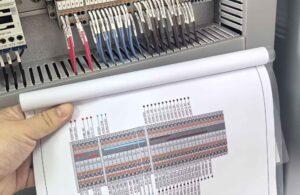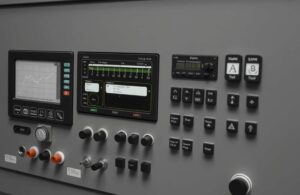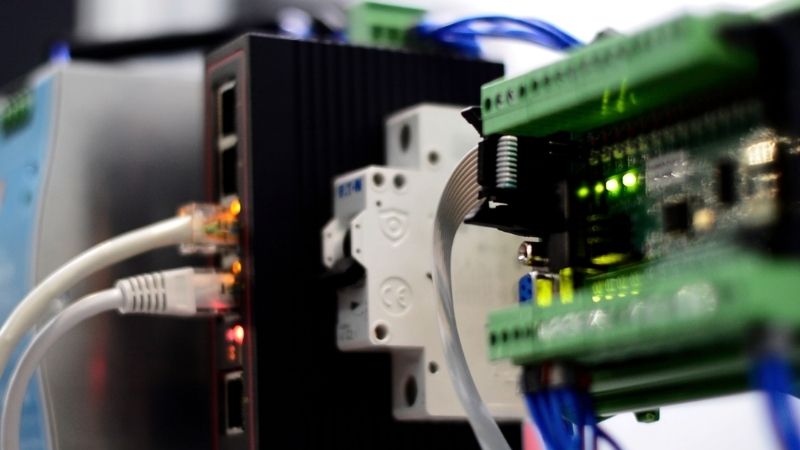PLC Analog Giriş ve Çıkış: Test ve Sorun Giderme Kılavuzu
Bu makalede, PLC analog giriş ve çıkışını inceleyeceğiz; bunlar, PLC'nin analog giriş ve çıkışına izin veren temel bileşenlerdir. PLC'ler sinyalleri ve kontrol süreçlerini doğru bir şekilde yönetmek için. Otomasyon sistemleriyle çalışıyorsanız, bu sinyallerin nasıl çalıştığını ve nasıl test edileceğini anlamak, verimliliği ve güvenilirliği korumak için çok önemlidir.
İçindekiler
PLC Analog Giriş ve Çıkışları Nelerdir?
PLC sisteminde analog giriş tam olarak nedir?
Bir PLC'deki analog giriş, ikili (0 veya 1) olan dijital bir sinyalin aksine, sürekli bir değer aralığı sağlayan bir sinyaldir. Analog girişler, sıcaklık sensörleri, basınç sensörleri veya akış ölçerler gibi harici cihazlardan veri almak için kullanılır. Bu cihazlar, PLC'nin endüstriyel süreçleri kontrol etmek veya izlemek için işleyebileceği bir analog sinyal (örneğin, 0 ila 10V, 4-20mA) çıkışı verir.
Anahtar Analog Giriş Aygıtları
- Sıcaklık sensörleri (örneğin, termokupllar, RTD'ler)
- Basınç sensörleri
- Akış ölçerler
- Seviye sensörleri
Bu sensörler fiziksel parametreleri (basınç, sıcaklık veya akış gibi) PLC'nin okuyabileceği, yorumlayabileceği ve tepki verebileceği elektrik sinyallerine dönüştürür.
PLC'lerde analog çıkışın işlevi nedir?
Öte yandan, analog çıkış PLC'nin aktüatörler, vanalar ve değişken hız gibi cihazları kontrol etmek için sürekli değişken sinyaller göndermesine olanak tanır sürücüler (VSD'ler). Örneğin, PLC'ler analog çıkışları kontrol etmek için kullanabilir motor hızlar, ısıtma elemanları veya giriş değeri üzerinde hassas kontrol gerektiren diğer cihazlar.
Analog çıkış akım (genellikle 4-20mA) veya voltaj (0-10V) şeklinde olabilir. PLC, istenen çıkış değerini bağlı cihazın anlayabileceği ve yanıtlayabileceği karşılık gelen bir analog sinyale dönüştürür.
Ana Analog Çıkış Aygıtları
- Değişken hızlı tahrikler (VSD'ler)
- Aktüatörler
- Isıtıcılar
PLC Analog Girişleri Nasıl Çalışır?
Analog giriş sinyali PLC'ye nasıl bağlanır?
Analog giriş sinyalini işleyebilmek için PLC'nin, gelen voltaj veya akım sinyalini PLC'nin CPU'sunun işleyebileceği bir forma dönüştüren bir analog giriş modülüne ihtiyacı vardır.
Örneğin, PLC'nin giriş modülü tarafından 4-20mA'lik bir akım sinyali alınacak ve PLC'nin kontrol amaçlı kullanabileceği dijital bir değere dönüştürülecektir.
PLC analog sinyalleri nasıl yorumlar?
Analog giriş sinyali alındığında, PLC analog sinyali dijital bir değere dönüştürmek için bir dönüştürücü modül (ADC – Analogdan Dijitale Dönüştürücü) kullanır. Bu dijital değer daha sonra PLC'nin programlamasında kararlar almak veya bir alarmı etkinleştirmek veya bir motorun hızını ayarlamak gibi eylemlerde bulunmak için kullanılır.
Örneğin, bir sıcaklık sensörü 0 ila 10V arasında bir sinyal çıkışı veriyorsa, PLC voltajı okur ve önceden tanımlanmış programlamaya dayanarak bunu belirli bir sıcaklık aralığını temsil edecek şekilde yorumlar.
PLC Sistemlerinde Analog Çıkışın Rolü Nedir?
PLC analog çıkışları cihazları nasıl kontrol eder?
PLC giriş verilerini aldıktan sonra, cihazları kontrol etmek için analog çıkışları kullanabilir. Örneğin, bir PLC analog bir girişten veri alabilir, işleyebilir ve ardından bir valf veya motor gibi bir cihazı kontrol etmek için karşılık gelen bir analog sinyal gönderebilir. Bu sürekli geri bildirim döngüsü, sürecin sorunsuz ve verimli bir şekilde çalışmasını sağlar.
Sıcaklık regülasyonu, motorların hız kontrolü, hatta bir boru sistemindeki basıncın ayarlanması gibi hassas kontrol gerektiren uygulamalarda analog çıkışlar büyük önem taşır.
Analog çıkış sinyali nasıl üretilir?
Analog çıkış sinyali genellikle PLC içindeki bir DAC (Dijital-Analog Dönüştürücü) modülü tarafından üretilir.
PLC yazılımı, DAC'ye dijital bir değer gönderir ve bu değer sürekli bir sinyale dönüştürülür; bir akım (4-20mA) veya voltaj (0-10V) çıkışı. Bu sinyal daha sonra kontrol cihazına iletilir.
PLC Analog Sinyalleri Etkili Bir Şekilde Nasıl Test Edilir?
PLC analog giriş ve çıkış sinyallerini test etmenin en iyi yolu nedir?
Sisteminizin düzgün çalıştığını doğrulamak için PLC analog sinyallerini test etmek önemlidir. İşte bunu nasıl yapabileceğiniz:
Analog Girişleri Test Etme:
- Giriş sinyalini ölçmek için bir multimetre kullanın sensör PLC giriş terminaline. Voltajın veya akımın beklenen aralıkta olduğunu doğrulayın (örneğin, 4-20mA veya 0-10V).
- Giriş sinyallerini bir sinyal üreteci veya simülatör kullanarak simüle edin. Bu, PLC'nin farklı değerlere doğru şekilde yanıt vermesini sağlamaya yardımcı olur.
Analog Çıkışların Test Edilmesi:
- PLC'nin analog çıkış terminalinden gelen çıkışı ölçmek için bir voltaj veya akım ölçer kullanın.
- Ayrıca çıktıyı simüle etmek ve bağlantıyı doğrulamak için bir döngü test cihazı da kullanabilirsiniz.
Analog sinyallerin test edilmesi, PLC sisteminin girişleri doğru bir şekilde okumasını ve doğru çıktıları üretmesini sağlar; bu da endüstriyel süreçlerde sorunsuz operasyonların sürdürülmesi için hayati önem taşır.
PLC'nin doğru çalışıp çalışmadığını nasıl anlarım?
PLC'nin sinyalleri doğru bir şekilde işlediğini doğrulamak için, PLC programını uygun ölçekleme ve kalibrasyon açısından kontrol edebilirsiniz. Örneğin, giriş sinyali aralığının (0-10V veya 4-20mA) sensörün teknik özellikleriyle eşleştiğinden emin olun.
Ayrıca, analog girişi manuel olarak ayarlayarak ve ilgili analog çıkışın beklendiği gibi değiştiğini doğrulayarak PLC'nin tepkisini test edebilirsiniz.
PLC Analog G/Ç ile İlgili Yaygın Sorunlar ve Bunları Çözme Yolları
PLC analog giriş okumalarım neden doğru değil?
Analog girişlerle ilgili yaygın bir sorun, giriş sinyalini bozabilen ve yanlış okumalara yol açabilen sinyal parazitidir. Bu, elektriksel gürültü, uygunsuz kablolama veya arızalı sensörlerden kaynaklanabilir. Bu sorunu çözmek için:
- Girişimi önlemek için kabloları koruyun.
- Sensör ve PLC'nin uygun şekilde topraklandığından emin olun.
- Arızalı sensörleri veya kabloları değiştirin.
Analog çıkış sorunlarını nasıl giderebilirim?
Analog çıkış beklendiği gibi davranmıyorsa, sorun DAC modülünde, kablolamada veya bağlı cihazda olabilir. Aşağıdakileri kontrol edin:
- Çıkış kartının düzgün bir şekilde yerleştirildiğinden emin olun.
- PLC ile aktüatör veya cihaz arasındaki bağlantıyı doğrulayın.
- Hatalı kablolama veya gevşek bağlantı olup olmadığını kontrol edin.
Sıkça Sorulan Sorular
PLC'lerde analog giriş ile analog çıkış arasındaki fark nedir?
Analog giriş, sensörlerden sürekli sinyaller almak için kullanılırken, analog çıkış, aktüatörler veya motorlar gibi kontrol cihazlarına sürekli sinyaller göndermek için kullanılır.
Multimetre olmadan PLC analog sinyallerini nasıl test edebilirim?
Analog sinyalleri simüle etmek için bir sinyal simülatörü kullanabilir ve PLC'nin tepkisini kontrol ederek düzgün çalışıp çalışmadığını doğrulayabilirsiniz.
Analog giriş voltajım neden stabil değil?
Bu, yakındaki ekipmandan kaynaklanan parazit, gevşek bağlantılar veya arızalı bir sensörden kaynaklanıyor olabilir. Tüm bağlantıların güvenli olduğundan emin olun ve kabloları korumaya çalışın.
Analog sinyali test için nasıl simüle edebilirim?
Çeşitli analog giriş seviyelerini (örneğin 0-10V veya 4-20mA) simüle etmek ve PLC'nin bu sinyalleri nasıl işlediğini doğrulamak için bir sinyal üreteci kullanabilirsiniz.
Projelerinize yepyeni, orijinal Omron, Mitsubishi, Schneider PLC'lerle güç katın - stokta, hemen kullanıma hazır!
Çözüm
- PLC analog girişi, sistemin sensörlerden sürekli sinyal almasını sağlarken, analog çıkış, cihazlara sürekli kontrol sinyalleri gönderir.
- PLC analog sinyallerinin düzenli olarak test edilmesi sistemden doğru okumaların ve tepkilerin alınmasını sağlar.
- Analog G/Ç'de sorun giderme, parazitlerin kontrol edilmesini, hatalı kablolamanın yapılmasını ve PLC programının doğru yapılandırılmasını içerir.
- Güvenilir analog işlemler için uygun kablolama, ekranlama ve kalibrasyon çok önemlidir.
PLC analog sistemlerinizi anlayıp bakımını yaparak otomasyon süreçlerini optimize edebilir, hataları azaltabilir ve genel sistem güvenilirliğini artırabilirsiniz.
Projeleriniz için yeni, orijinal PLC'ler mi arıyorsunuz? Kwoco'da, en iyi markaların en son PLC'lerini stoklarız: Omron, Mitsubishi, Ve Schneider. Güvenle alışveriş yapın—hızlı kargo, garantili kalite! Hemen Satın Al
Bize Ulaşın
Bu forma adınızı, e-posta adresinizi ve sorunuzun kısa bir açıklamasını girmeniz yeterlidir. 24 saat içinde sizinle iletişime geçeceğiz.
Bu Konuları da İlginizi Çekebilir

PLC Rehberi: Kavramlar, Uygulamalar ve Kablolama Esasları
Bu belge, Programlanabilir Mantık Denetleyicisi'nin (PLC) temel kavramlarını, güçlü yeteneklerini ve temel kablolama metodolojilerini kapsayan kapsamlı bir analizini sunar. Geleneksel röle tabanlı kontrol sistemlerini PLC tabanlı sistemlerle karşılaştırarak, PLC'lerin modern endüstriyel otomasyondaki vazgeçilmez rolünü vurgulayacağız. PLC'lerin beş temel uygulama alanını (Dijital Kontrol, Hareket Kontrolü, Analog Kontrol, Veri İşleme ve İletişim ve Ağ) keşfederek ve tablolar ve veriler kullanarak farklı çıktı türlerinin özelliklerini analiz ederek, bu makale yeni başlayanlar, mühendisler ve teknoloji meraklıları için ayrıntılı bir giriş kılavuzu görevi görmektedir.

Otomasyon Sistemi Nedir?
Otomasyon sistemleri, mal ve hizmet üretme şeklimizi dönüştürerek modern endüstrilerin omurgası haline geldi. Bu makale, otomasyon sisteminin ne olduğunu, farklı otomasyon türlerini ve günümüz dünyasında neden önemli olduklarını ele alıyor. Sonunda, otomasyonun endüstrileri ve günlük yaşamı nasıl etkilediğini anlayacaksınız ve bu, teknolojinin geleceği hakkında meraklı olan herkes için okunması gereken bir kitap haline geliyor.

Kwoco'nun Küresel Ticaret Şirketleriyle Başarılı İşbirliği
Kwoco'nun Küresel Ticaret Şirketleriyle Başarılı İşbirliği Günümüzün küresel pazarında, tedarik zincirinin güvenilirliği doğrudan






